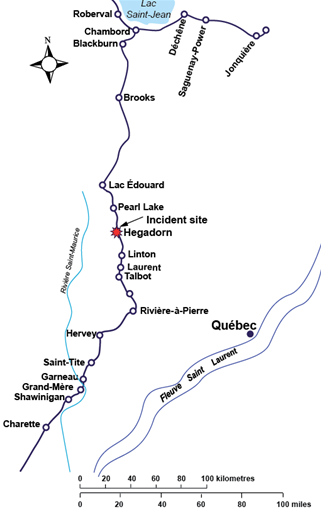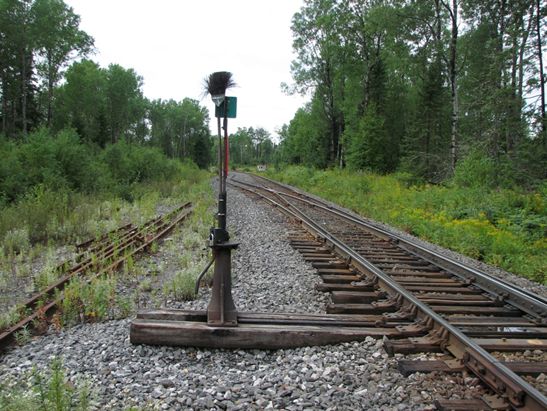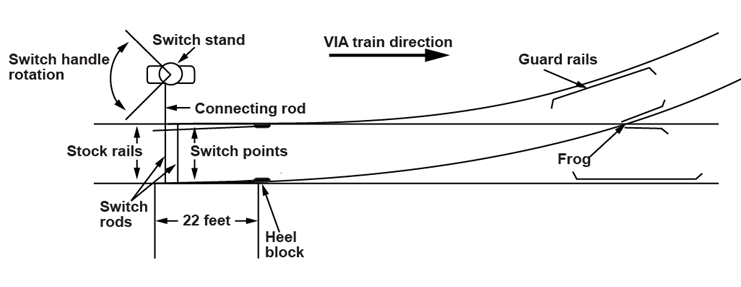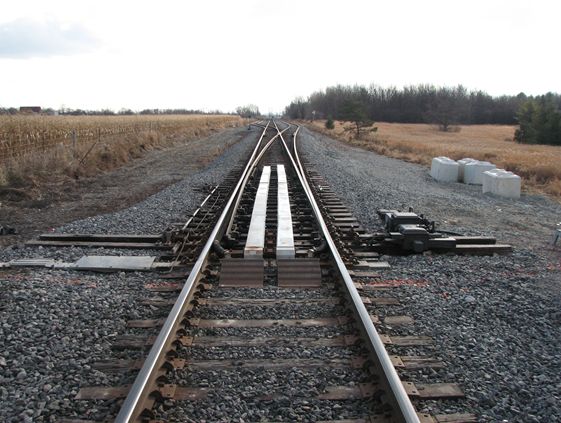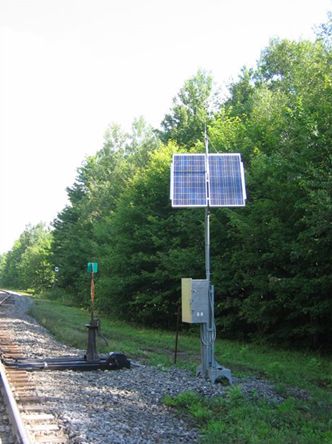Misaligned switch and track diversion
VIA Rail Canada Inc.
Passenger Train P600-21-09
Mile 78.11, Canadian National
Lac St-Jean Subdivision
Hegadorn, Quebec
The Transportation Safety Board of Canada (TSB) investigated this occurrence for the purpose of advancing transportation safety. It is not the function of the Board to assign fault or determine civil or criminal liability. This report is not created for use in the context of legal, disciplinary or other proceedings. See Ownership and use of content. Masculine pronouns and position titles may be used to signify all genders to comply with the Canadian Transportation Accident Investigation and Safety Board Act (S.C. 1989, c. 3).
Summary
On 09 August 2012, at approximately 1235 Eastern Daylight Time, VIA Rail Canada Inc. passenger train P600-21-09 was proceeding southward on the Canadian National Lac St-Jean Subdivision when it unexpectedly diverted into the siding at Hegadorn, Quebec, Mile 78.11. All the equipment remained on the track and there was no damage. A total of 59 passengers and the train crew were on board. No one was injured.
Factual information
On 09 August 2012, at approximately 0810, Footnote 1 VIA Rail Canada Inc. (VIA) passenger train P600-21-09 (the train) departed Jonquière, Quebec, and travelled southward on the main track of the Canadian National (CN) Lac St-Jean Subdivision en route to Montréal, Quebec, with 59 passengers on board. The trip from Jonquière was uneventful. At about 1235, the train approached the north turnout of the JM33 siding track at Hegadorn, Quebec (Figure 1), at a speed of 36 mph with the throttle in position 0. The turnout’s red target indicated that the switch was in the reverse position. Noticing that the switch target was aligned for the diverging route, the train crew verbally confirmed the situation. Footnote 2 The locomotive engineer then tried to stop and, realizing that he would not be able to do so before the turnout, applied the emergency brakes. The train slowed down and passed over the turnout at about 24 mph without overturning. Locomotive VIA 6439 stopped on the siding track, about 270 feet past the JM33 switch. Coaches VIA 8146 and VIA 8622 remained coupled to the locomotive.
The train consisted of 1 locomotive and 2 coaches. It weighed about 250 tons and was approximately 225 feet long. The crew consisted of 2 locomotive engineers (the operating locomotive engineer (the engineer) and the in-charge locomotive engineer), who were familiar with the territory, met fitness and rest standards and were fully qualified for their respective positions. A third locomotive engineer was on board to familiarize himself with operating procedures following a period of leave. He had briefly gone into one of the coaches when the incident occurred. An on-board service manager, who was fully qualified for his position and met company standards and regulatory requirements, Footnote 3 was responsible for passenger safety and comfort.
After the train came to a stop, the on-board service manager went through the train and found that no one had been injured. The crew members contacted the rail traffic controller (RTC) to inform him that the emergency brakes had been applied and that the train had entered the siding. They then inspected the train and the switch. No damage to the train was observed. The crew noticed that the switch was in the reverse position and that it was locked that way with a high-security lock. The lock showed no signs of vandalism.
The sky was overcast and the temperature was 22°C.
Site examination
The area near Hegadorn is mountainous and wooded. In the vicinity of the turnout, the railway right-of-way is about 99 feet wide. It was overrun by dense vegetation, reducing the sightlines at and near the curves.
The turnout at the north end of the Hegadorn siding is a hand-operated No. 12 switch designed to switch trains travelling at a maximum speed of 15 mph. The switch stand mast measures 48 inches and is equipped with an oblong standard red target and a small red reflectorized target that faces north when the switch is in the reverse position. The switch stand is positioned on the east side of the track, on the same side as the diverging route. A switch broom is located on the switch stand (Photo 1). The switch components (Figure 2) were in good condition and properly adjusted and maintained.
The turnout is situated on tangent track, about 400 feet south of a left curve, in the direction of the train movement. A rocky overhang runs several hundred feet on the east side of this 3.25° curve. That obstacle, which is about 15 feet from the centre of the track, obstructs the crew’s field of vision when the train is travelling south and approaching the north siding switch at Hegadorn (Photo 2).
Lac St-Jean subdivision information
The Lac St-Jean Subdivision is a single main track that runs from Garneau Yard, Mile 0.0, near St-Georges, Quebec, to Arvida, Quebec, Mile 203.5. Train movements are governed by the Occupancy Control System (OCS) authorized by the Canadian Rail Operating Rules (CROR) and supervised by an RTC in Montréal. The subdivision is a Class 3 track according to the Transport Canada (TC)–approved Railway Track Safety Rules (TSR). According to the CN timetable, the maximum authorized speed in the incident area is 35 mph for passenger trains and 30 mph for freight trains. Rail traffic consists of 2 freight trains and 1 passenger train per day, representing close to 8.7 million gross tons per year.
All the Lac St-Jean Subdivision switches are hand-operated, except at the remotely controlled interlocking at Hervey. The main track has approximately 600 curves and runs through mostly rural or wooded areas. A train travelling southward encounters 29 curves of various lengths that can reach up to 8° over the 10-mile stretch leading up to the Hegadorn siding.
In 2005, in order to better meet operational needs, the Hegadorn siding was extended by approximately 3500 feet to the north.
Track information
The track consists of 115-pound continuous welded rail laid on 14-inch double-shouldered tie plates with 3 spikes per tie. There are about 3200 hardwood ties per mile of track. The rail is box-anchored every tie. The ballast, consisting mainly of ½-inch to 2-inch crushed rock, was in good condition and showed no sign of fouling. The cribs were full and the shoulders were at least 16 inches wide. The embankment could reach up to 7 feet high.
Track maintenance crew
On the day of the incident, a track maintenance crew was scheduled to inspect the track and to replace the switch bolts at the Hegadorn siding switch. The crew assigned to this task consisted of 2 members who were familiar with the territory, met fitness and rest standards and were fully qualified for their respective positions. The foreman had been a CN employee since 1979 and the trackman had worked sporadically for CN since 1995.
Based on the information gathered during the investigation, the following tasks were performed and the following events occurred:
- Starting at 0655, the crew foreman requested and obtained his first OCS clearance for the day, authorizing him to conduct a hi-rail inspection between Lac Édouard (Mile 96.0) and Linton (Mile 61.9).
- Around 0800, the hi-rail vehicle met freight train CN 368, requiring the crew to clear the main track, south of the Hegadorn siding.
- The visual inspection was then completed up to Linton, and the crew turned back towards the north turnout of the Hegadorn siding to perform the scheduled work. The hi-rail vehicle was positioned just beyond the switch.
- The switch was placed in neutral to make it easier for the crew to replace 2 gauge rod bolts.
- After a call from CN 369, Footnote 4 which was travelling south, the switch was placed in the reverse position, allowing the hi-rail vehicle to clear the main track by reversing into the siding.
- The switch was placed back in the normal position and locked for the train to pass.
- After the train passed, the switch was reversed and the hi-rail vehicle moved forward past the switch points.
- The switch remained unlocked and in the neutral position. Two more bolts were replaced.
- Once the scheduled work was completed, the switch was placed back in the normal position and verified.
- After observing that the points were tightly closed, the switch was turned again and locked, and the key was removed.
- Around 1000, the tools were collected and placed in the truck.
- At 1008, the crew obtained a new clearance and travelled north, performing other maintenance tasks up to the crossing at Mile 90.75, where they cleared the main track.
Return to Hegadorn
After the passenger train passed the Hegadorn north switch and stopped, the RTC contacted the track maintenance crew to inform them that the switch had been found in the reverse position.
At 1241, the crew obtained clearance to return to Hegadorn. By the time they arrived, the train had already departed.Footnote 5 The maintenance crew inspected the turnout and the track. No damage was observed.
Track inspections
Several types of inspections were performed in the past year:
- Regular and special hi-rail vehicle inspections were performed in the incident area in accordance with the TSR. The last regular inspection was conducted the morning of the incident and no defect was found.
- On 18 June 2012, a track geometry inspection was performed by a track evaluation car. A few spots with excessive gauge were found. Work was performed to correct these urgent defects.
- Three continuous inspections for internal rail defects had been performed since the beginning of 2012. A few defects were found near the occurrence location during the last inspection on 31 July 2012. The affected rails were replaced.
- The turnouts are inspected every month. The last inspection of turnout JM33, performed on 05 July 2012, revealed no defects.
Main-track hand-operated switches
CROR Rule 104 explains the procedure for the use of main-track hand-operated switches in OCS territory. The following procedures are pertinent to this occurrence:
(b) […] When a switch has been turned, the points must be examined and the target, reflector or light, if any, observed to ensure that the switch is properly lined for the route to be used.
(h) […] Except as provided in paragraph (i), main track switches must be left lined and locked in normal position.
(i) A main track switch may be left in the reverse position when;
- directed by GBO [General Bulletin Order], clearance or special instructions, Footnote 6 and protection has been provided against all affected movements,
- attended by an employee, who must be in position to restore the switch to normal before it is occupied by an approaching movement on the main track,
- occupied by equipment,
- required in the application of Rule 840.2,
- In OCS or Cautionary Limits;
- equipment is left on the main track,
- the equipment is left as close as practical near the switch, and
- operation over the same switch is required when returning to such equipment,
- In CTC [Centralized Traffic Control System], equipment is left within the same controlled block. When this cannot be done, RTC permission must be obtained.
(q) The employee handling a main track hand-operated switch in a non-signalled territory must, from the location of the switch, communicate with another rules qualified employee to confirm the position in which the switch has been left, lined and locked. The employee receiving this report must repeat it back to the employee who handled the switch [….]
Main-track switch targets
In accordance with standard railway operating practices in Canada, main-track switch targets are regarded as position indicators used to assist a train crew in pinpointing the exact location of a switch, in addition to indicating the switch position. Unless train crew members have been formally notified that they may encounter a specific switch lined and locked in the reverse position or are instructed to use a specific switch, they are not required to adjust their train speed to be able to stop short of reversed switches. Footnote 7
In general, regardless of track curvature or visibility, train crew members are expected to operate their trains as closely as possible to the maximum authorized speed
JM33 switch target visibility test
On 15 August 2012, the TSB conducted a simulation at the occurrence location to determine the sightlines for the JM33 switch target for a train approaching from the north. The test was performed at around 1200, approximately at the same time of day and in similar weather conditions as on the day of the incident. The investigation revealed that the colour and geometry of the target were discernible from the 3.25° curve at a distance of approximately 650 feet.
Event recorder
Data from the VIA 6439 locomotive event recorder were examined (Table 1).
| Time | Mile | Speed (mph) | Brake pipe (lb) | Brake application (lb) | Event |
|---|---|---|---|---|---|
| 1233:35.1 | 37.8 | 99 | 0 | Throttle at 0 | |
| 1233:44.3 | 36.9 | 99 | 0 | ||
| 1233:46 | 78.23 | 37.8 | 99 | 0 | Exited the curve |
| 1233:47.8 | 36.9 | 96 | 0 | Loss of pressure = emergency brake application | |
| 1233:48 | 36.9 | 66 | 0 | ||
| 1233:48.2 | 36.9 | 40 | 0 | ||
| 1233:48.4 | 36.9 | 18 | 0 | ||
| 1233:48.6 | 36.9 | 7 | 0 | ||
| 1233:48.8 | 36.9 | 2 | 5 | Emergency brake activation | |
| 1233:48.9 | 36.9 | 0 | 5 | ||
| 1233:51 | 35.7 | 0 | 33 | Loss of speed | |
| 1233:52.1 | 34.8 | 0 | 45 | ||
| 1233:54.1 | 32.5 | 0 | 68 | ||
| 1233:56.2 | 29.2 | 0 | 89 | ||
| 1234 | 78.11 | 23.6 | 0 | 90 | Speed at the switch |
| 1234:5.2 | 15.4 | 0 | 90 | ||
| 1234:10.8 | 5.1 | 0 | 90 | ||
| 1234:13.4 | 78.06 | 0 | 0 | 90 | Stop |
The train would have travelled approximately 920 feet before coming to a stop, factoring in a 1- to 2-second reaction time by the locomotive engineer and train speed of about 52 feet per second.
Similar occurrence
On 20 June 2012, while conducting a regular hi-rail vehicle inspection, the assistant track supervisor found this same switch in the reverse position (R12Q0018). A production gang had likely left the switch in the reverse position and locked it when leaving the work site.
Following this occurrence, discussions were held with members of the production gang involved. However, there is no indication that other immediate action had been taken to improve the safety of main-track hand-operated switches in OCS territory.
The VIA 600 engineer had heard about this incident and paid special attention as the locomotive approached the turnout.
Statistics on switches found in the reverse position
Between 01 January 2002 and 31 August 2012, 77 occurrences, including this one, have been reported to the TSB concerning main-track switches in the reverse position:
- 9 occurrences involved passenger trains, 63 involved freight trains and 5 involved work trains or maintenance vehicles.
- 35% (27/77) of the movements were unable to stop before reaching the switch in the reverse position.
- 67% (6/9) of the passenger trains were unable to stop before reaching the switch in the reverse position.
- None of the cases resulted in derailment.
Laboratory examination of high-security safety devices
Four approved high-security devices (Photo 3) were sent to the TSB Laboratory to determine whether this type of lock could be opened with something other than a key without damaging the device.
The results of the examination (LP 217/2012) are as follows:
- Metal wire, drill bits, screws or nails were used to attempt to pry the lock open, with no success (Photo 4).
- An experienced person with in-depth knowledge of internal lock mechanisms and special tools could conceivably open the lock without damaging it.
High-security lock keys
The use of high-security switch locks was one outcome of the Canadian Transport Commission (Commission) inquiry into VIA passenger train speeds that was prompted by the derailment of a VIA passenger train in June 1984 following an act of vandalism to a main-track switch on CN’s Smith Falls Subdivision, Ontario. Following this accident, the Commission issued several orders (1986), making the installation of high-security switch locks mandatory for main-track hand-operated switches on:
- non-signalled passenger train routes;
- non-signalled established passenger train detour routes;
- non-signalled freight train routes where speed exceeds 30 mph; and
- sidings where cars containing dangerous goods are frequently placed.
The high-security lock keys were distributed to qualified railway employees. The investigation revealed that, when the locks were first introduced, a record was kept of employees who were given keys but that this practice is no longer observed. Although CN and VIA had systems in place to track key holders, the subsequent distribution of keys was not continuously recorded.
Existing technologies
The Transportation Development Centre (TDC), on behalf of TC Rail Safety, contracted the Transportation Group at the University of New Brunswick to conduct a study to identify the existence and availability of technologies capable of providing advance information to train crews on the position of hand-operated switches on non-signalled rail lines. The study was designed to conduct a technical and scientific review of existing technologies using surveys directed to universities, research and/or development centres and suppliers/manufacturers of signalling equipment.
Completed in November 2001, report TP 13853E revealed that cost-effective and reliable systems could be installed to indicate the position of hand-operated switches on non-signalled rail lines. Approximately 10 devices were identified.
A sophisticated system is in use in the Toronto area. Since June 2012, a 10 000-foot siding (Photo 5) at Mile 19.6 of GO Transit’s Newmarket Subdivision has been equipped with a dual-tone multi-frequency (DTMF) communication system (Photo 6). Using a radiotelephone keypad to establish contact, a digital recording can confirm turnout locations and the position of the switches. This system can even be used to remotely control power-operated switches and reverse the switch position if necessary. At this location, a 3-colour light system (red, yellow and green) indicates the switch point alignment. A track de-icing system allows the switches to move freely when there is snow.
A similar system is currently in operation at the Salomé siding, located at Mile 110.31 of CN’s Joliette Subdivision (Photo 7).
Item 1.10 of the Joliette Subdivision footnotes of the 01 May 2011 CN timetable specifies in part:
- Siding south switch at Salome is equipped with a switch point detector with talker. The purpose of this detector is to determine the position of the switch points and to broadcast a message on request.
Requesting the talker message is mandatory for all through movements in a facing point direction over the switch. On trailing point movements, the Talker message is to be requested when a Rule 104 warning is issued for that switch on an OCS clearance. The talker is to be activated at or before the advance designated signs located two miles from switch by depressing sequence #11031 on channel 1.
- The following are the three messages the talker can transmit:
- Switch in normal position
- “Siding South Switch Salome is in Normal position, Switch is in Normal position.”
- Switch in reversed position
- “Warning ... Siding South Switch Salome is in reversed position, Switch is in reversed position.”
- Switch points not closed
- “Warning … Warning … Siding South Switch Salome is not lined properly, Switch is not lined properly.”
In addition, in territories controlled by the Centralized Traffic Control System (CTC) or by OCS within a series of consecutive blocks where Automatic Block Signal (ABS) system rules apply, track circuits and wayside signals give advance warning to train crews that they are approaching a switch in the reverse position. These advance warnings are not given in OCS territory where there is no ABS.
Analysis
No equipment or track defects were considered a contributing factor in this occurrence. This analysis will focus on the cause and contributing factors of the incident, including the work performed, braking and stopping distance, movement control, defences against switches left in the reverse position, and other technologies.
The incident
The incident took place when the train arrived at a misaligned switch and was diverted into the siding. On the day of the incident, the track maintenance crew was to replace switch bolts at the Hegadorn siding. In order to replace the bolts, the switch stand was handled a few times to release the tension on the switch rods and adjust the alignment of the switch points. After completing the work, the crew members retrieved the lock key and left the site without going back over the switch, Footnote 8 thinking that they had left it in the normal position, as required. Employees can lock switches in either the normal or reverse position to retrieve their lock key.
The possibility that someone reversed the switch between the crew’s departure and the train’s arrival was considered. Given the location, the time available, the fact that there was no evidence of lock tampering and the difficulty with opening this type of lock, it is unlikely that someone else handled the lock. Consequently, the switch was inadvertently locked in the reverse position after the maintenance crew handled it.
According to Rule 104, an employee who handles a switch must communicate with another employee to confirm the position in which the switch was left and locked. The other employee must repeat it back. To be effective, this administrative rule requires the full attention of the employees when performing this procedure.
Replacing switch gauge rod bolts is a routine task. Inadvertent mistakes Footnote 9 can happen when employees are not paying close attention to a routine task. Footnote 10 The crew’s attention was split between placing the north siding switch in the normal position, cleaning the site, collecting the tools and planning the next move. The crew did not verify the exact position of the switch after it was last handled.
To work safely in a subdivision, locomotive engineers must be familiar with locomotive operations and with the subdivision characteristics. In this occurrence, when approaching the switch, the locomotive engineer was vigilant and attentive to the track condition. He paid special attention because he knew that a switch had been left in the reverse position a few weeks earlier.
The locomotive engineer detected the hazardous situation almost as soon as it was possible to do so and applied the emergency brakes. Given the topography of the surrounding area and the fact that there was a curve of more than 3°, the sightline for the target was about 650 feet. Given the track configuration, the target’s sightline was reduced. There was not enough braking distance for a train travelling at the authorized speed to stop before reaching the switch.
Administrative defences
A similar occurrence took place on 20 June 2012 at the same location. However, CN did not use that incident as an opportunity to send a safety message to its Engineering employees. This occurrence was therefore a missed opportunity for the railway to send an important message to improve the safety of main-track hand-operated switches in OCS territory.
Although statistics show that situations where switches are left in the reverse position do not happen often, the fact remains that the potential consequences can be severe, especially for a passenger train. Some safeguards are in place to manage the risks associated with such situations.
CROR Rule 104 is the main defence for preventing a main-track hand-operated switch in OCS territory from being left in the reverse position. This incident shows that qualified employees can sometimes inadvertently leave a switch in the reverse position. In addition, Rule 34 requires that railway employees recognize and observe the fixed signals along rail tracks. Safety therefore depends on how employees interpret instructions and whether they fully comply with operating rules.
Also, the target may be considered an effective defence provided it can be seen. However, in some situations, sightlines may be restricted by track configuration, weather conditions or vegetation. When sightlines are restricted, a train travelling at the authorized speed may not be able to stop before reaching a switch left in the reverse position, increasing the risk of derailment.
Existing technologies in OCS territory
A study commissioned by TC in November 2001 showed that systems can be installed to indicate the position of hand-operated switches on non-signalled rail lines. Since June 2012, a sophisticated system on GO Transit in Vaughan uses a radiotelephone keypad to confirm the location of turnouts and the position of the switches. This system can even remotely control power-operated switches and reverse the switch position if necessary. CN uses a similar system at Salomé. Connected to a voice annunciator system (talker), it was installed to determine the position of switches. The talker sends a radio message on request.
These technologies offer an effective way to protect movements approaching main-track hand-operated switches in OCS territory. When a control system cannot detect that the siding switch is in the reverse position, the RTC cannot provide the necessary information for the movement’s safety, increasing the operating risks.
Findings
Findings as to causes and contributing factors
- The switch was inadvertently locked in the reverse position after the maintenance crew handled it and left the site.
- The crew did not verify the exact position of the switch after it was last handled.
- Given the track configuration, the target’s sightline was reduced. There was not enough braking distance for a train travelling at the authorized speed to stop before reaching the switch.
- The incident took place when the train arrived at a misaligned switch and was diverted into the siding.
Findings as to risk
- When sightlines are restricted, a train travelling at the authorized speed may not be able to stop before reaching a switch left in the reverse position, increasing the risk of derailment.
- When a control system cannot detect that the siding switch is in the reverse position, the rail traffic controller (RTC) cannot provide the necessary information for the movement’s safety, increasing the operating risks.
Other findings
- Given the location, the time available, the fact that there was no evidence of lock tampering and the difficulty opening this type of lock, it is unlikely that someone else handled the lock.
- Due to the vigilance of the operating locomotive engineer, the hazardous situation was detected almost as soon as it was possible to do so.
- The previous similar occurrence was a missed opportunity for the railway to send an important message to improve the safety of main-track hand-operated switches in Occupancy Control System territory.
Safety action
Safety action taken
On 10 August 2012, Canadian National (CN) issued Bulletin 2012-08-E-01 and introduced a supplement to Rule 104(q) to Engineering – Eastern Region employees:
- Employees must write the following information on the back of their clearance when handling a main track switch in OCS:
- Time of Day
- Location of the switch
- Initials of employees’ that either handled or confirmed the position of switch
- Position the switch was left
In addition, the Regional Chief Engineer held a conference call with all Engineering – Eastern Region employees to discuss the occurrence and to clearly explain the expectations regarding Rule 104(q).
During the week of 21 August 2012, managers conducted blitz campaigns to ensure compliance with safety standards.
This report concludes the Transportation Safety Board’s investigation into this occurrence. Consequently, the Board authorized the release of this report on . It was officially released on 4 September 2013.
